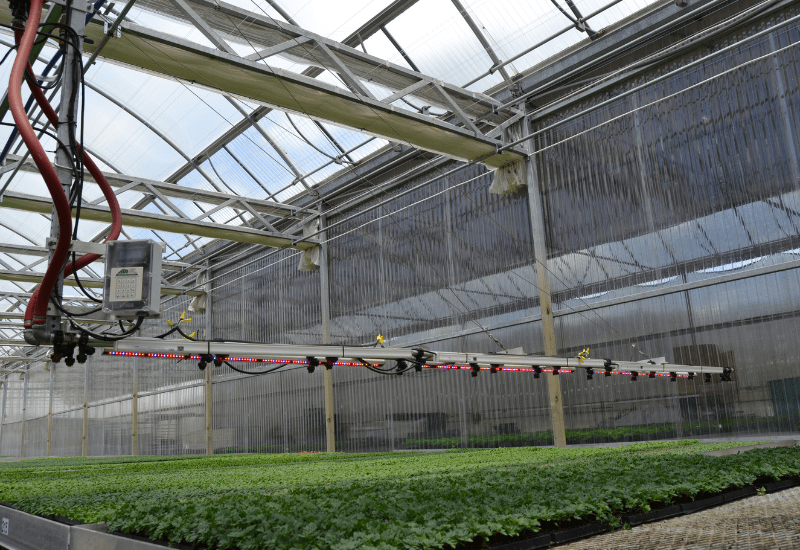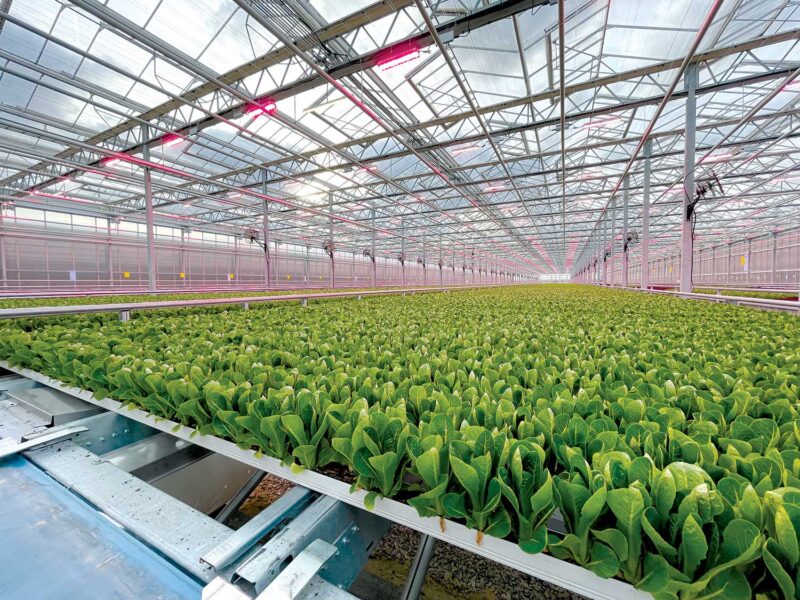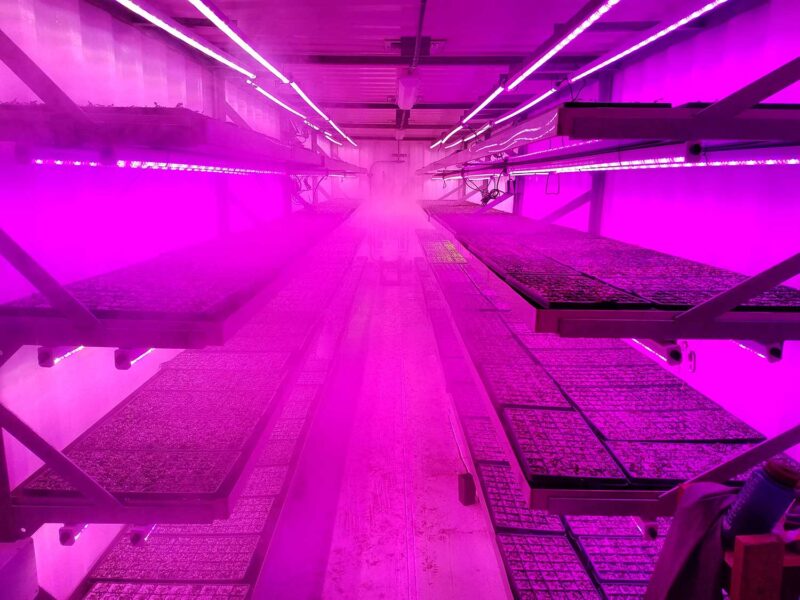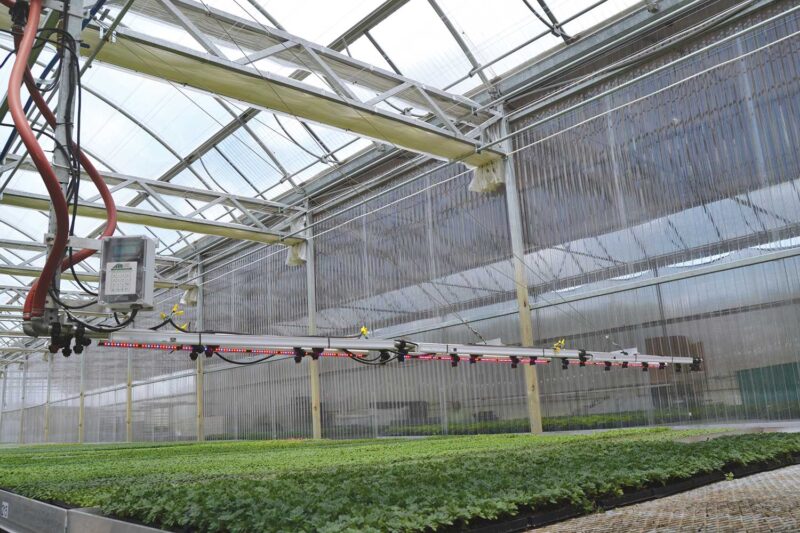
Now is the time for LED lighting
As more controlled environment growers install LED grow lights, those who haven’t may question whether they are missing out on the benefits of adding these lights to their operations. It depends a lot on the crops they’re growing.
“When considering grow lights, trends and innovations do not impact all crops the same,” said Chris Higgins, president of Hort Americas, a commercial horticulture distributor in Bedford, Texas. “Grow lights can be looked at from the perspective of growing a crop for units or growing a crop for yield. Ornamental plant growers produce and sell units — packs, pots, baskets, etc. They are not trying to sell a specific weight. Most times, they are trying to produce flowers and hit a minimum plant size dimension.
“Most controlled environment food crop growers are paid for plant yields, which includes lettuce, tomatoes, peppers, cucumbers and strawberries. The trend continues to be: How hard can these growers push their crops? How much light intensity can be delivered to the plants and how much light intensity can growers afford to put on their plants?”
HOW IMPORTANT IS SUPPLEMENTAL LIGHTING?
For ornamental growers, the impact of supplemental light on production is fairly minimal, Higgins said.
“Ornamental growers are either trying to extend the day, shorten the day or keep the days the same length with a certain light intensity,” he said. “On average, these growers run their grow lights for 500 to 1,500 hours a year. For growers on the lower end of that range, light is just not that important.

“Those growers currently without lights, who would only operate the lights for a short duration, are likely waiting to see the cost of the lights come down. They’re also probably considering waiting for a utility incentive or rebate to help justify the cost to lower capital expenditures and provide a return on investment in less than five years,” Higgins said.
Horticulture professor Erik Runkle, who heads up the controlled environment lighting laboratory at Michigan State University, works primarily with ornamental plant growers.
“For Michigan ornamental growers, LED grow lights make the most sense for those who propagate plants during the winter and early spring, and those who produce crops that are shipped to the South, where the market opens up earlier in the year,” Runkle said.
“This typically would be wholesale growers who are producing crops during December through the spring. For growers, especially retail growers who start their crops later in the spring, the economics of LED lights are much less favorable. They don’t see the benefit of making the investment. If growers aren’t starting their crops until March, the natural light levels are starting to increase. These growers might use the lights for maybe a month. The payback for a month of extra light is going to take a long time to achieve,” he said.
Higgins said the type of ornamental crops growers are producing can also impact whether or not investing in LED lights makes sense.
“The majority of ornamental greenhouse growers are producing short-term crops,” he said. “Long-term crops like poinsettias and orchids should have more value per square foot of production area. The more value there is per square foot of plant production, the more sense it makes to consider installing lights so as to ensure quality crop production.
“The only time there is unquestionable value investing in lights for a short-term crop is in propagation facilities where there is a direct correlation between square footage and profit. Successful propagators continually produce high quality, highly uniform young plants that ship well and require minimal touches per tray while in production.”
Young plant propagation has a lot in common with greenhouse food crop production, including crops like lettuce, Higgins said.
“It depends on how the crop is grown and what makes it valuable,” he said. “It often comes down to the amount of time a crop spends in the greenhouse where quality is directly related to the ability to control or manipulate the climate combined with the value per square foot of crop production.”

LIMITED LIGHT IMPROVEMENTS
Higgins said he’s surprised the horticulture industry still spends a considerable amount of time focused on LED lights.
“LED lights are 15 years old and we know a lot about the lights and crops and it’s not really new technology,” he said. “Manufacturers have done a good job of constantly creating new stories about their products. The reality is we are reaching a point where there are diminishing returns with the new innovations and advancements in technology.
“The most efficient LED lights deliver at least 3.0 micromoles per joule. Once the lights achieve 3.4-3.5 micromoles per joule there really isn’t much opportunity to improve efficiency. That level of efficiency is approaching the limits of LEDs, unless there is some unanticipated technological breakthrough.”
LEDs continue to improve, but at a decreasing rate, Runkle said.
“Every year or two, many manufacturers introduce a new improved version,” he said. “The difference from the previous version is typically less.
“For example, a manufacturer says this year’s fixtures are between 5-7% more efficient than the ones offered last year. Growers who purchased last year’s model are probably not going to regret their decision to buy last year’s model because they have already used those lights for a year.
“If a grower bought the fixtures five years ago, those on the market today could be 30% more efficient. That’s a meaningful amount. The lights are getting better, but the rate of increase in efficiency, the rate of improvement has slowed down.
“While growers may be waiting for an improved fixture, they are missing out on the opportunity to save at least 50% on their utility bills or possibly taking advantage of utility rebates that may not be available next year. There’s really no compelling reason to wait unless a grower doesn’t have the money available to purchase the lights,” Runkle said.

GROW LIGHT FEATURES
One feature that many growers want with their grow lights is the ability to dim the lights.
“From an operational standpoint, dimming the lights has huge advantages,” Higgins said. “Dimming the lights is going to have a direct impact on the growers’ utility bills. If a grower is operating 1,000-watt LED grow lights, and the lights are operated at 500 watts, the grower is only using half the electricity.”
Higgins said many ornamental growers won’t spend the extra money to make lights dimmable.
“The trend is every light has to be dimmable in order to be salable,” he said. “There is an additional expense to dim the lights. Either a hard wire has to be run back to a control panel that has been set up for dimming, or a grower has to purchase a device to run the lights wirelessly.”
Another potential feature that Higgins sees coming is the addition of far-red light to the grow light spectrum.

“In another two years I expect LED grow lights will have the ability to manage far-red light,” he said. “This will enable growers to turn off the PAR (photosynthetically active radiation) light and only deliver far-red light. PAR light is photosynthetic light. Far-red light controls plant morphology by helping to determine internode length.”
The benefit of adding far-red light is crop specific.
“In the case of strawberries and cucumbers, being able to elongate the stems can be beneficial,” he said. “Addition of far-red light can allow strawberries to grow out of the crown of the plant so that there is less chance of Botrytis infection and enables the fruit to hang away from the plants so it is easier to harvest. The improved plant structure also allows for more airflow around the fruit so there is less chance for Botrytis to develop.”
Far-red light is the light humans can’t see, but plants perceive.
“Far-red light does things to regulate leaf size or leaf area and influences the architecture or shape of a plant, sometimes in positive ways, sometimes in negative ways,” Runkle said. “There is the potential to increase overall photosynthesis which could result in larger leaves. The advantage to producing larger leaves is the potential to capture more sunlight or more light from the grow lights, which could increase growth, flowering and fruiting.”
For more information call HortAmericas at 469-532-2383, or visit hortamericas.com. Erik Runkle, Michigan State University, Department of Horticulture, runkleer@msu.edu; canr.msu.edu.









 Video Library
Video Library 


















